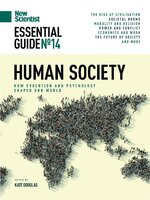The Essential Guide series brings together the best recent coverage from New Scientist specially curated into beautiful compendiums about the most exciting themes in science and technology today. Written and edited by some of the world’s best science writers, these guides will leave you with everything you need to know about subjects from nutrition to the solar system and more.
NEW SCIENTIST ESSENTIAL GUIDE THE DAWN OF CIVILISATION
New Scientist - The Essential Guides
CHAPTER 1 THE ORIGINS OF CIVILISATION
SOPHISTICATED HUNTER-GATHERERS • It is tempting to assume that the switch from hunter-gatherer to farmer is a form of positive progress. However, this misrepresents hunter-gatherer societies.
THE FIRST FARMERS • The invention of farming is one of the most important acts of creativity in human history. It was so important that we did it several times on multiple continents.
TINKERING WITH NATURE • The first people to try farming may have tinkered with it out of curiosity while still hunting and gathering.
FROM GARDENS TO FARMS • The transition from hobbyist gardening to true agriculture took a long time, and many societies never made the switch.
ANIMALS AS FRIENDS, AND FOOD • As well as plants, our ancestors also domesticated animals. This happened long before the advent of farming.
THE FARMING “TRAP” • Farming didn’t necessarily bring nutritional gains or other health benefits. So why did people take it up?
THE RISE OF COMPLEX SOCIETIES • Why did some farming societies become dramatically more complex – developing powerful hierarchies and new technologies like money?
SOCIETY SPOTLIGHT: AMAZONIA • A huge society existed in the Amazon rainforest for thousands of years before the arrival of Europeans. It had domesticated crops and even cities – but not as we know them.
CHAPTER 2 THE ARTS
BUT IS IT ART? • Art isn’t an easy thing to define. Nor is it easy to decide whether any non-human animals make it.
A CULTURAL EXPLOSION? • Archaeologists used to think expressive art began around 40,000 years ago in Europe. This “cultural explosion” turns out to be an illusion.
ART BEFORE HUMANS • There is growing evidence that art is not only more than 40,000 years old, it predates our species. It now seems clear that Neanderthals were also artists.
PAINT AND AXES • Few artworks more than 40,000 years old have survived. But other lines of evidence suggest that the roots of creativity go far deeper even than the Neanderthals.
ARTISTS BEYOND EUROPE • Just as art didn’t emerge in a cultural explosion 40,000 years ago, Stone Age creativity wasn’t confined to Europe.
WHAT’S IT ALL ABOUT? • The million-dollar question is what Stone Age hand stencils, drawings and symbols mean. There have been some intriguing suggestions
HOW I’M BRINGING ANCIENT MUSIC BACK TO LIFE • What did Palaeolithic pop sound like? To find out, researchers recreate long-forgotten instruments, writes Rupert Till.
SOCIETY SPOTLIGHT: INDIGENOUS AUSTRALIANS • Humans may have reached Australia as early as 65,000 years ago. Once they were there, they created some remarkable artworks.
CHAPTER 3 WRITING
PROTO-WRITING • Writing has a long prehistory. Millennia before the invention of formal writing systems, people began playing with simple abstract signs.
JOINING THE DOTS • Writing entails combining simple, abstract signs together to create words. This conceptual leap appears to have deep origins.
CRACKING THE CODE • It’s one thing to understand that our ancestors “wrote” in a prehistoric code on cave walls, quite another to work out what they meant.
TRUE WRITING EMERGES • True writing can be traced to around 5000 years ago, a time when the Sumerian culture...

 EG25
EG25
 EG24
EG24
 EG23
EG23
 EG22
EG22
 EG21
EG21
 EG20
EG20
 EG19
EG19
 EG18
EG18
 EG17
EG17
 EG16
EG16
 EG15
EG15
 EG14
EG14